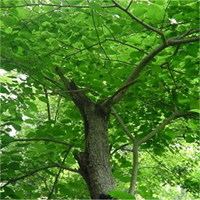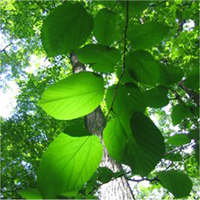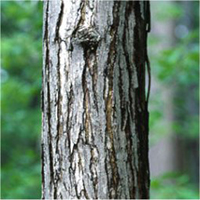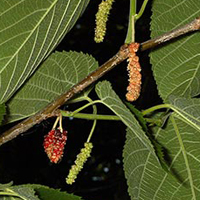Red Mulberry (Species at Risk)
Scientific name: Morus rubra




Cover photos credit: Tree: Katie Brasted; Leaf: Steven J. Baskauf; Bark: Natural Resources Canada, Canadian Forest Service; and Fruit: Allen Woodliffe.
Status
Endangered
“Endangered” means the species lives in the wild in Ontario but is facing imminent extinction or extirpation.
Date added to the Species at Risk in Ontario List
The Red Mulberry was already assessed as endangered when the Endangered Species Act took effect in 2008. It was re assessed as endangered in 2015.
Read the report (PDF)
What it looks like
Red Mulberry is a small tree that grows 6-18 metres tall. The leaves are quite large, and heart-shaped. The bark of mature trees is reddish in colour and flaky. The fleshy fruit is deep red and matures in mid-July.
Where it lives
In Ontario, Red Mulberry grows in moist, forested habitats and on both sandy and limestone-based loamy soils.
It is often found in areas where the forest canopy is quite open and allows lots of sunlight to reach the forest floor, but it will tolerate some shade.
Where it’s been found in Ontario
Red Mulberry occurs in eastern North American forests. In Canada, it is only found in the Carolinian Zone (the small area of Ontario southwest of Toronto to Sarnia down to the shores of Lake Erie) near rivers, the shores of Lake Erie, and the slopes of the Niagara Escarpment.
View a Larger version of this map (PDF)
What threatens it
The greatest threat to Red Mulberry is cross-breeding with the non-native White Mulberry. A variety of diseases, including twig blight and dieback, weaken individual trees. Prolonged drought will also cause decline and death of trees
Habitat destruction due to agriculture and urban development continues to threaten this species. Invasive species may directly or indirectly threaten Red Mulberry by changing the forest structure where it lives.
Action we are taking
Endangered species and their general habitat are automatically protected.
Recovery strategy
A recovery strategy advises the ministry on ways to ensure healthy numbers of the species return to Ontario.
Read the executive summary (January 11, 2013)
Read the recovery strategy (January 11, 2013)
Government response statement
A government response statement outlines the actions the government intends to take or support to help recover the species.
Read the government response statement (October 11, 2013)
Five-year review of progress
A five-year review of progress made toward protecting and recovering a species is required no later than five years after the government response statement for that species is published.
Read the report on progress towards the protection and recovery of 17 species at risk, including Red Mulberry (2018).
Habitat protection
General habitat descriptions are technical, science-based documents that provide greater clarity on the area of habitat protected for a species.
Read the general habitat description (July 2, 2013)
What you can do
Report a sighting
Report a sighting of an endangered animal or plant to the Natural Heritage Information Centre. Photographs with specific locations or mapping coordinates are always helpful.
Volunteer
Volunteer with your local nature club or provincial park to participate in surveys or stewardship work focused on species at risk.
Be a good steward
- Private land owners have a very important role to play in species recovery; if you find red mulberry on your land, you may be eligible for stewardship programs that support the protection and recovery of species at risk and their habitats
- Invasive species seriously threaten many of Ontario’s species at risk; to learn what you can do to help reduce the threat of invasive species, visit:
- There is a program geared to eligible farms registered under the Canada-Ontario Environmental Farm Plan to encourage greater protection and conservation of habitat for species at risk
- The Carolinian forests of southern Ontario support an amazing diversity of plants and wildlife, including many species at risk; Carolinian Canada is working to help recover species at risk and their habitats
Report illegal activity
Report any illegal activity related to plants and wildlife to
Quick facts
- There are fewer than 300 Red Mulberry trees remaining in Ontario.
- Unlike most fruit trees that are pollinated by insects, the flowers of Red Mulberry are pollinated by the wind.
- Red Mulberry can be easily confused with the non-native White Mulberry and hybrids of the two species.
